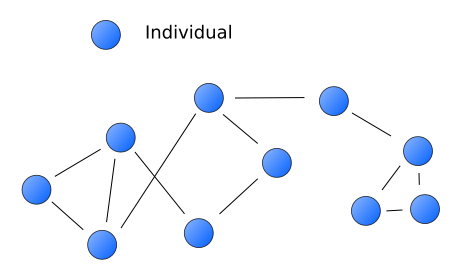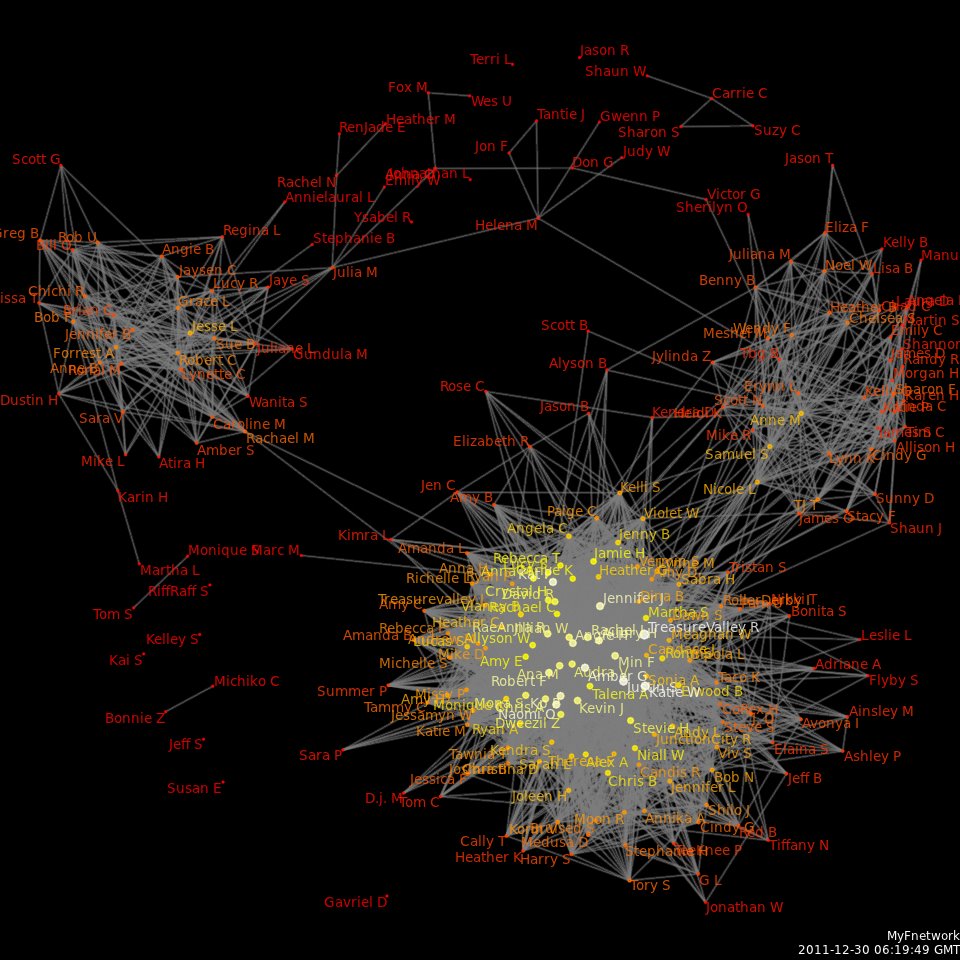|
Social Network (sociolinguistics)
In the field of sociolinguistics, social network describes the structure of a particular speech community. Social networks are composed of a "web of ties" (Lesley Milroy) between individuals, and the structure of a network will vary depending on the types of connections it is composed of. Social network theory (as used by sociolinguists) posits that social networks, and the interactions between members within the networks, are a driving force behind language change. Structure Participants The key participant in a social network is the ''anchor'', or center individual. From this anchor, ties of varying strengths radiate outwards to other people with whom the anchor is directly linked. These people are represented by ''points''. Participants in a network, regardless of their position, can also be referred to as ''actors ''or ''members''. Relationships There are multiple ways to describe the structure of a social network. Among them are ''density, member closeness centrality, ... [...More Info...] [...Related Items...] OR: [Wikipedia] [Google] [Baidu] |
Sociolinguistics
Sociolinguistics is the descriptive study of the effect of any or all aspects of society, including cultural norms, expectations, and context, on the way language is used, and society's effect on language. It can overlap with the sociology of language, which focuses on the effect of language on society. Sociolinguistics overlaps considerably with pragmatics and is closely related to linguistic anthropology. Sociolinguistics' historical interrelation with anthropology can be observed in studies of how language varieties differ between groups separated by social variables (e.g., ethnicity, religion, status, gender, level of education, age, etc.) and/or geographical barriers (a mountain range, a desert, a river, etc.). Such studies also examine how such differences in usage and differences in beliefs about usage produce and reflect social or socioeconomic classes. As the usage of a language varies from place to place, language usage also varies among social classes, and it is t ... [...More Info...] [...Related Items...] OR: [Wikipedia] [Google] [Baidu] |
African American Vernacular English
African-American Vernacular English (AAVE, ), also referred to as Black (Vernacular) English, Black English Vernacular, or occasionally Ebonics (a colloquial, controversial term), is the variety of English natively spoken, particularly in urban communities, by most working- and middle-class African Americans and some Black Canadians. Having its own unique grammatical, vocabulary, and accent features, AAVE is employed by middle-class Black Americans as the more informal and casual end of a sociolinguistic continuum. However, in formal speaking contexts, speakers tend to switch to more standard English grammar and vocabulary, usually while retaining elements of the nonstandard accent. Despite being widespread throughout the United States, AAVE should not be assumed to be the native dialect of all African Americans. As with most African-American English, African-American Vernacular English shares a large portion of its grammar and phonology with the rural dialects of the Southe ... [...More Info...] [...Related Items...] OR: [Wikipedia] [Google] [Baidu] |
Social Network Analysis
Social network analysis (SNA) is the process of investigating social structures through the use of networks and graph theory. It characterizes networked structures in terms of ''nodes'' (individual actors, people, or things within the network) and the ''ties'', ''edges'', or ''links'' (relationships or interactions) that connect them. Examples of social structures commonly visualized through social network analysis include social media networks, memes spread, information circulation, friendship and acquaintance networks, business networks, knowledge networks, difficult working relationships, social networks, collaboration graphs, kinship, disease transmission, and sexual relationships. These networks are often visualized through ''sociograms'' in which nodes are represented as points and ties are represented as lines. These visualizations provide a means of qualitatively assessing networks by varying the visual representation of their nodes and edges to reflect attributes of in ... [...More Info...] [...Related Items...] OR: [Wikipedia] [Google] [Baidu] |
Mark Granovetter
Mark Sanford Granovetter (; born October 20, 1943) is an American sociologist and professor at Stanford University. He is best known for his work in social network theory and in economic sociology, particularly his theory on the spread of information in social networks known as ''The Strength of Weak Ties'' (1973). In 2014 Granovetter was named a Citation Laureate by Thomson Reuters and added to that organization’s list of predicted Nobel Prize winners in economics. Data from the Web of Science show that Granovetter has written both the first and third most cited sociology articles. Education Granovetter earned an Bachelor of Arts degree in history at Princeton University (1965) and a PhD in sociology at Harvard University (1970). At Harvard his research was supervised by Harrison White. Career and research Granovetter is currently the Joan Butler Ford Professor in the School of Humanities and Sciences at Stanford and is the chair of the Department of Sociology. He previous ... [...More Info...] [...Related Items...] OR: [Wikipedia] [Google] [Baidu] |
Indexicality
In semiotics, linguistics, anthropology, and philosophy of language, indexicality is the phenomenon of a ''sign'' pointing to (or ''indexing'') some object in the context in which it occurs. A sign that signifies indexically is called an index or, in philosophy, an indexical. The modern concept originates in the semiotic theory of Charles Sanders Peirce, in which indexicality is one of the three fundamental sign modalities by which a sign relates to its referent (the others being iconicity and symbolism). Peirce, C.S., "Division of Signs" in ''Collected Papers'', 1932 897 Peirce's concept has been adopted and extended by several twentieth-century academic traditions, including those of linguistic pragmatics, linguistic anthropology, and Anglo-American philosophy of language. Words and expressions in language often derive some part of their referential meaning from indexicality. For example, ''I'' indexically refers to the entity that is speaking; ''now'' indexically refers to a ti ... [...More Info...] [...Related Items...] OR: [Wikipedia] [Google] [Baidu] |
Fist Bump
A fist bump (also known as a bro fist or power five) is a gesture similar in meaning to a handshake or high five. A fist bump can also be a symbol of giving respect or approval, as well as companionship between two people. It can be followed by various other hand and body gestures (such as immediately opening the palm and spreading the fingers for “knucks with explosions”) and may be part of a dap greeting. It is commonly used in sports as a form of celebration with teammates and with opposition players at the beginning or end of a game. Fist bumps are often given as a form of friendly congratulation. Definition A fist bump is a gesture in which two people bump their fists together (as in greeting or celebration). The gesture is performed when two participants each form a closed fist with one hand and then lightly tap the front of their fists together. A participant's fists may be either vertically oriented (perpendicular to the ground) or horizontally oriented. Unlike t ... [...More Info...] [...Related Items...] OR: [Wikipedia] [Google] [Baidu] |
Computational Linguistics
Computational linguistics is an Interdisciplinarity, interdisciplinary field concerned with the computational modelling of natural language, as well as the study of appropriate computational approaches to linguistic questions. In general, computational linguistics draws upon linguistics, computer science, artificial intelligence, mathematics, logic, philosophy, cognitive science, cognitive psychology, psycholinguistics, anthropology and neuroscience, among others. Sub-fields and related areas Traditionally, computational linguistics emerged as an area of artificial intelligence performed by computer scientists who had specialized in the application of computers to the processing of a natural language. With the formation of the Association for Computational Linguistics (ACL) and the establishment of independent conference series, the field consolidated during the 1970s and 1980s. The Association for Computational Linguistics defines computational linguistics as: The term "comp ... [...More Info...] [...Related Items...] OR: [Wikipedia] [Google] [Baidu] |
Linguistic Insecurity
Linguistic insecurity comprises feelings of anxiety, self-consciousness, or lack of confidence in the mind of a speaker surrounding their use of language. Often, this anxiety comes from speakers' belief that their speech does not conform to the perceived standard and/or the style of language expected by the speakers' interlocutor(s). Linguistic insecurity is situationally induced and is often based on a feeling of inadequacy regarding personal performance in certain contexts, rather than a fixed attribute of an individual. This insecurity can lead to stylistic, and phonetic shifts away from an affected speaker's default speech variety; these shifts may be performed consciously on the part of the speaker, or may be reflective of an unconscious effort to conform to a more prestigious or context-appropriate variety or style of speech.Bucci, Wilma, and Milton Baxter. "Problems of Linguistic Insecurity in Multicultural Speech Contexts." Annals of the New York Academy of Sciences 433 ... [...More Info...] [...Related Items...] OR: [Wikipedia] [Google] [Baidu] |
Computer-mediated Communication
Computer-mediated communication (CMC) is defined as any human communication that occurs through the use of two or more electronic devices. While the term has traditionally referred to those communications that occur via computer-mediated formats (e.g., instant messaging, email, chat rooms, online forums, social network services), it has also been applied to other forms of text-based interaction such as text messaging. Research on CMC focuses largely on the social effects of different computer-supported communication technologies. Many recent studies involve Internet-based social networking supported by social software. Forms Computer-mediated communication can be broken down into two forms: synchronous and asynchronous. Synchronous computer-mediated communication refers to communication that occurs in real-time. All parties are engaged in the communication simultaneously; however, they are not necessarily all in the same location. Examples of synchronous communication are vi ... [...More Info...] [...Related Items...] OR: [Wikipedia] [Google] [Baidu] |
Diffusion Curve Of Linguistic Variants On A Condensed Time Scale
Diffusion is the net movement of anything (for example, atoms, ions, molecules, energy) generally from a region of higher concentration to a region of lower concentration. Diffusion is driven by a gradient in Gibbs free energy or chemical potential. It is possible to diffuse "uphill" from a region of lower concentration to a region of higher concentration, like in spinodal decomposition. The concept of diffusion is widely used in many fields, including physics ( particle diffusion), chemistry, biology, sociology, economics, and finance (diffusion of people, ideas, and price values). The central idea of diffusion, however, is common to all of these: a substance or collection undergoing diffusion spreads out from a point or location at which there is a higher concentration of that substance or collection. A gradient is the change in the value of a quantity, for example, concentration, pressure, or temperature with the change in another variable, usually distance. A change i ... [...More Info...] [...Related Items...] OR: [Wikipedia] [Google] [Baidu] |
Harlem
Harlem is a neighborhood in Upper Manhattan, New York City. It is bounded roughly by the Hudson River on the west; the Harlem River and 155th Street (Manhattan), 155th Street on the north; Fifth Avenue on the east; and 110th Street (Manhattan), Central Park North on the south. The greater Harlem area encompasses several other neighborhoods and extends west and north to 155th Street, east to the East River, and south to Martin Luther King, Jr., Boulevard (Manhattan), Martin Luther King Jr. Boulevard, Central Park, and 96th Street (Manhattan), East 96th Street. Originally a Netherlands, Dutch village, formally organized in 1658, it is named after the city of Haarlem in the Netherlands. Harlem's history has been defined by a series of economic boom-and-bust cycles, with significant population shifts accompanying each cycle. Harlem was predominantly occupied by Jewish American, Jewish and Italian American, Italian Americans in the 19th century, but African-American residents began to ... [...More Info...] [...Related Items...] OR: [Wikipedia] [Google] [Baidu] |



